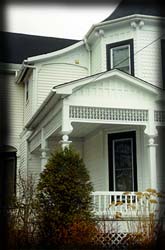|

|
115
UPTON ROAD, SAULT STE. MARIE
HISTORY
On May 22, 1902,
William L. Beers, a local hotel-keeper, sold lots 4
and 5 of the Simpson subdivision to Martha J.
Stewart for $750. A few months later, on August 4,
1902, her husband Edward L. Stewart, the manager of
the International Lumber Company, sold to her lot 6
for $425. By June 19th, Edward Stewart had begun
the excavation for his residence on Upton Road,
then estimated to cost $3,500. The contractor,
Thomas McKissock, had the frame of the house up by
late July. That same month the Sault Star noted
that the basement of the house was constructed of
concrete and had cost $1,000. The house, 58 feet by
34 feet, was to be finished in red quartered stone.
The price had escalated to $6,000.
|

|
By 1908,
the Stewarts no longer resided at 115
Upton. The house was the residence of
various tenants, including F. Hedley
Marsh, manager of the Imperial Bank of
Canada, Alfred M. Peters, manager of the
Bank of Montreal, and J. Frater Taylor,
vice-president of the Lake Superior
Corporation. The Stewarts, however,
continued their ownership of 115 Upton
until July, 1911 when the house was sold
for $7,500 to Archibald D. McLean, manager
of the Canadian Bank of Commerce.
|
Archibald
McLean sold the house in 1918 to Michael Paris, a
merchant, for the exact same price he had
originally paid. Like the Stewarts, McLean had not
resided at 115 Upton for the last three years of
his ownership, possibly indicating that 1915 was
the year he had moved to London, Ontario.
Michael Paris died
in May, 1923. Maria, his widow, carried on the
family grocery and butcher business and continued
living at the house until October, 1925 when she
sold it to Robert A. Campbell, an electrical
engineer, and Robert George Campbell, the city
clerk. In September, 1947, Jane M. Campbell, widow
of Robert George Campbell, sold her half interest
in the house to Robert A.Campbell for $3,000.
Robert Campbell maintained ownership of the house
until 1967 when Margaret Anne Barnett, and Lawrence
Fred Barnett, both tenants at 115 Upton, purchased
the house. In 1971 Patrick Laurence Rooney and lone
Anne Rooney, its present owners, purchased 115
Upton Road. The Rooneys subdivided the property in
1979. The house, however, was not affected. The
home is now owned by Dr. and Mrs. Bruce
Skinner.
BUILDING DESCRIPTION
|
The home
at 115 Upton Road is a substantial,
gracious residence sited north of the
Hearst residence on the west side of
Upton. The plan is cruciform shaped with
the head forming the main east elevation.
The arms and head of the cross are of
approximately equal height and width. The
main facade and the verandah which wraps
it are the most prominent features of the
house.
|

|
The walls of
the centre portion of the main elevation are
splayed at both first and second floors giving this
section of the house a turret-like appearance. This
feature, combined with the angles of the tent roof,
which rises above the remaining roof levels,
further emphasises the dominance of the formal
living areas of the house. Early photographs of the
property indicate the verandah was originally
accessed by two sets of identical steps at each
end, their location emphasised by the positioning
of a classical pediment. The tympanum of each
pediment has been treated with applied battens
vertically and horizontally to give a panelled
effect. Below the tympanum a continuous horizontal
frieze has been created with a series of wood
spindles alternating with one and two disks. This
frieze must be considered one of the major
decorative elements of the house adding a lightness
of effect, matching with the lattice work below the
verandah and equating well with the rythym of the
ballustrading, all in contrast to-the robust
massing of the house itself.
|

|
The
columns supporting the verandah roof are
of unusual design, consisting of eight
inch square posts with shamfered corners
terminating in a capital consisting of a
sphere sitting on top of a square abacus
but also capped with an identical item
which in turn carries a stub post
supporting the veranda roof
structure.
Although
the verandah is classical in style, the
remainder of the house has a distinctly
Victorian Gothic air. Eastlake influence
is also apparent in the robust posts,
balusters and brackets which contrast with
the finer details of the frieze and
lattice work; together they emphasised the
three dimensional quality of the
house.
|
Early
photographs of the house indicate that all the main
framing posts both horizontal and vertical were
emphasized in light paint colours whereas the
horizontal siding and shingles were painted in a
much darker colour. Although the house has been
reclad in a modern siding and the original second
floor south-east balcony enclosed, the renovations
were carried out with considerable sympathy for the
original sense of scale and much credit must be
given to the present owners for the care with which
they have updated the residence whilst retaining
its original handsome character.


|




